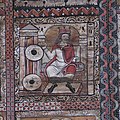St. Martin (Zillis)
The church of St. Martin stands in the center of the village of Zillis in the Swiss canton of Graubünden and is a Romanesque hall church , world-famous for its painted church ceiling.
Emergence
The church was first mentioned in a document as ecclesia plebeia in 831. Excavations and coin finds confirm that there was already a settlement here in Roman times and that the first church was built around the year 500.
Description of the church ceiling
The church ceiling is a work of art from the High Romanesque era and one of the very rare works of this kind that has been preserved almost completely and without overpainting (see Old Church (Dädesjö) in Sweden ). The ceiling was painted around 1109 to 1114 and consists of 153 square picture panels (9 rows of 17 panels) with a side length of approx. 90 cm. Most are made of fir wood and were first primed with a thin layer of plaster , then painted upright and only then inserted into the ceiling. The graphic style of the pictures indicates that the now unknown artist must have mastered book illumination .
The ceiling consists of 48 edge fields and 105 inner fields. The edge fields, which with the exception of the four corner fields only show scenes on the water (continuous wave band), together probably represent an ocean. There are mostly strange sea monsters ( mythical creatures ) designed in the form of hybrid creatures as symbols of evil as well as three scenes Ships seen from depicting the story of Jonah . On the four corner fields, however, standing on firm ground, angels are arranged as the personification of the four winds and heralds of the Last Judgment . The inner pictures, which show all scenes on the mainland, are dedicated to the following themes from the life of Christ : King David , Solomon and Rehoboam as the ancestors of Christ, then the Annunciation and the story of the Magi , the flight into Egypt and the murder of children Bethlehem . This is followed by the baptism of Jesus and then the teaching and miracles of Christ . After the Lord's Supper , the story of suffering ends with the crowning of thorns . The last series of pictures reports on the life of St. Martin .
Program of the church ceiling
The current arrangement of the picture panels is no longer the original, but follows an art historical reconstruction carried out by Erwin Poeschel in 1939 . Therefore, when attempting to subject the picture ceiling as a whole and thus also the arrangement of the panels to an interpretation, a certain restraint is required. Nevertheless, it is undisputed that the representations are closely related to cosmological ideas of their time of origin: The division of the ceiling into an inner zone, which represents the mainland and the history of salvation, and an outer zone, which forms an ocean strip populated by sea monsters, corresponds to one of image scheme known from medieval world maps (see mappa mundi and e.g. the Ebstorf world map or the London Psalter map ). The relationship between the Zillis ceiling and world maps of this type, which can have a round or rectangular basic shape, is also indicated by the following: the former, like certain mappae mundi, contains representations of the four winds on its edges. Comparable to some of these world maps, the Zillis ceiling is also constructed in such a way that the shape of a cross is visible in its overall layout (in Zillis this effect is achieved by the fact that the median strips that cross in the center of the ceiling are the only ones framed by double ornamental strips and thereby especially emphasized). [1]
Church organization
Zillis-Reischen with the Martinskirche forms an independent parish within the Evangelical Reformed regional church of Graubünden . This is in pastoral community with the parishes of the Schamserberg and belongs to the Colloquium II Schams-Avers-Rheinwald-Moesa .
Individual evidence
[1] Cf. Flühler-Kreis, Dione, The Romanesque picture ceiling of the Church of St. Martin in Zillis reconsidered, pp. 383–399.
literature
- Jürgen Thies: The symbols of Romanesque and evil: the Romanesque picture ceiling of the St. Martin church in Zillis / Graubünden in focus. , Nürtingen 2008.
- Huldrych Blanke: Zillis - Gospel in Pictures. The Romanesque picture ceiling in Zillis / Graubünden reinterpreted. Zurich and Eschbach, 1994.
- Flühler-Kreis, Dione, The Romanesque picture ceiling of the Church of St. Martin in Zillis reconsidered: Image system and image program, in: The Romanesque picture ceiling of the Church of St. Martin in Zillis: Basics for conservation and care, ed. v. Christine Bläuer Böhm et al., Bern / Stuttgart / Vienna 1997, pp. 383-403.
- Susanne Brugger-Koch: The Romanesque picture ceiling of St. Martin, Zillis (Graubünden). Style and iconography. Dissertation, Basel 1981 (manuscript print).
- Ernst Murbach, Peter Heman: Zillis. The Romanesque picture ceiling of the Church of St. Martin. Zurich and Freiburg im Breisgau 1967.
- Erwin Poeschel, The Romanesque ceiling paintings by Zillis. Erlenbach-Zurich 1941.
- ders .: The art monuments of the canton of Graubünden. Vol. V, Basel 1943, pp. 223ff.
- Dieter Rudloff: Zillis. The Romanesque picture ceiling of the Church of St. Martin. Basel 1989.
- Alfred Wyss: The security work on the Martinskirche in Zillis , in: Unser Kunstdenkmäler XXIV 1973/2, p. 107ff.
- Christine Bläuer Böhm, Hans Rutishauser, Marc Antoni Nay, The Romanesque picture ceiling by Zillis. Basics of conservation and care. Bern 1997.
- Marc Antoni Nay: St. Martin in Zillis. (Swiss Art Guide, No. 835, Series 84). Ed. Society for Swiss Art History GSK. Bern 2008, ISBN 978-3-85782-835-5 .
- Dieter Matti: Old pictures - reinterpreted, church art in the pass country. Volume 1 (Mittelbünden); Desertina, Chur 2012, ISBN 978-3-85637-368-9 , pp. 47-50.





